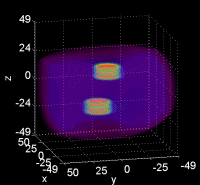 Study of Vortex Ring Dynamics in the
Nonlinear Schrödinger Equation utilizing
GPU-Accelerated High-Order Compact Numerical Integrators
Study of Vortex Ring Dynamics in the
Nonlinear Schrödinger Equation utilizing
GPU-Accelerated High-Order Compact Numerical Integrators
Ph.D. Dissertation in Computational
Science.
Ronald M. Caplan
Committee Chair: Professor Ricardo Carretero.
Abstract:
We numerically study the dynamics and interactions of vortex rings in the
nonlinear Schrödinger equation (NLSE). Single ring dynamics for both bright and dark vortex rings are explored including their traverse velocity, stability, and perturbations resulting in quadrupole oscillations. Multi-ring dynamics of dark vortex rings are investigated, including scattering and merging of two colliding rings, leapfrogging interactions of co-traveling rings, as well as co-moving steady-state multi-ring ensembles.
Simulations of choreographed multi-ring setups are also performed, leading to intriguing interaction dynamics.
Due to the inherent lack of a closed form solution for vortex rings and the dimensionality where they live, efficient numerical methods to integrate the NLSE have to be developed in order to perform the extensive number of required simulations. To facilitate this, compact high-order numerical schemes for the spatial derivatives are developed which include a new semi-compact modulus-squared Dirichlet boundary condition. The schemes are combined with a fourth-order Runge-Kutta time-stepping scheme in order to keep the overall method fully explicit. To ensure efficient use of the
schemes, a stability analysis is performed to find bounds on the largest usable time step-size as a function of the spatial step-size.
The numerical methods are implemented into codes which are run on NVIDIA
graphic processing unit (GPU) parallel architectures. The codes running on the GPU are shown to be many times faster than their serial counterparts. The codes are developed with future usability in mind, and therefore are written to interface with MATLAB utilizing custom GPU-enabled C codes with a MEX-compiler interface. The codes are combined into a software package called NLSEmagic which is freely distributed on a dedicated website allowing reproducibility of the simulations presented in the study.
Reproducible Figure Package
Download the reproducible figure package for use with the full research scripts of NLSEmagic v013 here: (RMC_Dissertation_Figures_Reproduce.zip).